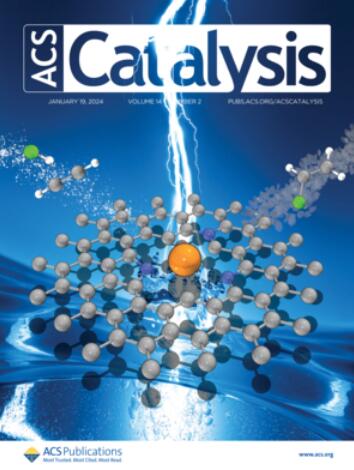Photoredox-Neutral Ni-Catalyzed Decarboxylative Fluoroalkylation via Radical Sorting Cross-Coupling
IF 11.3
1区 化学
Q1 CHEMISTRY, PHYSICAL
引用次数: 0
Abstract
The C(sp3/sp2)-C(sp3) linkages are undoubtedly important in modern organic synthesis. The number and variety of oxidative addition-driven photoredox neutral nickel-catalyzed C(sp3)-C(sp2) couplings have increased significantly in recent years. However, neutral radical–radical cross-coupling to form C(sp3/sp2)-C(sp3) bonds remains an important but elusive goal for engineering coupling reactions, especially in regulating cross-selectivity. In this article, we report an efficient photoredox-neutral Ni-catalyzed highly chemoselective decarboxylative fluoroalkylation via radical–radical cross-coupling of carboxylic acids and α-CF3 alkyl bromides. Detailed mechanistic studies elucidated the decarboxylation in an oxidative process that is orthogonal to α-CF3 alkyl bromide activation via oxidative addition, and radical sorting of two coupling partners with different electronic effects offers the possibility of tuning the rate of radical addition of the two radicals to achieve good cross-selectivity. A wide range of fluoroalkyl halides and carboxylic acids bearing a diverse set of substituents were compatible to produce valuable aliphatic CF3 chiral products under mild conditions.

光氧化还原中性镍催化自由基分选交叉偶联脱羧氟烷基化
C(sp3/sp2)-C(sp3)键在现代有机合成中无疑是重要的。近年来,氧化加成驱动的光氧化还原中性镍催化C(sp3)-C(sp2)偶联的数量和种类显著增加。然而,中性自由基-自由基交叉偶联形成C(sp3/sp2)-C(sp3)键仍然是工程偶联反应的一个重要但难以实现的目标,特别是在调节交叉选择性方面。在本文中,我们报道了通过羧酸和α-CF3烷基溴的自由基-自由基交叉偶联,高效光氧化还原中性镍催化的高化学选择性脱羧氟烷基化反应。详细的机理研究阐明了氧化过程中的脱羧与α-CF3烷基溴氧化加成活化是正交的,对两个具有不同电子效应的偶联伙伴进行自由基分选可以调节两个自由基的加成速率,从而实现良好的交叉选择性。多种含不同取代基的氟烷基卤化物和羧酸在温和条件下可相容生产有价值的脂肪族CF3手性产物。
本文章由计算机程序翻译,如有差异,请以英文原文为准。
求助全文
约1分钟内获得全文
求助全文
来源期刊

ACS Catalysis
CHEMISTRY, PHYSICAL-
CiteScore
20.80
自引率
6.20%
发文量
1253
审稿时长
1.5 months
期刊介绍:
ACS Catalysis is an esteemed journal that publishes original research in the fields of heterogeneous catalysis, molecular catalysis, and biocatalysis. It offers broad coverage across diverse areas such as life sciences, organometallics and synthesis, photochemistry and electrochemistry, drug discovery and synthesis, materials science, environmental protection, polymer discovery and synthesis, and energy and fuels.
The scope of the journal is to showcase innovative work in various aspects of catalysis. This includes new reactions and novel synthetic approaches utilizing known catalysts, the discovery or modification of new catalysts, elucidation of catalytic mechanisms through cutting-edge investigations, practical enhancements of existing processes, as well as conceptual advances in the field. Contributions to ACS Catalysis can encompass both experimental and theoretical research focused on catalytic molecules, macromolecules, and materials that exhibit catalytic turnover.
 求助内容:
求助内容: 应助结果提醒方式:
应助结果提醒方式:


